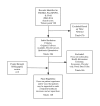Patient Portals and Patient Engagement: A State of the Science Review
- PMID: 26104044
- PMCID: PMC4526960
- DOI: 10.2196/jmir.4255
Patient Portals and Patient Engagement: A State of the Science Review
Abstract
Background: Patient portals (ie, electronic personal health records tethered to institutional electronic health records) are recognized as a promising mechanism to support greater patient engagement, yet questions remain about how health care leaders, policy makers, and designers can encourage adoption of patient portals and what factors might contribute to sustained utilization.
Objective: The purposes of this state of the science review are to (1) present the definition, background, and how current literature addresses the encouragement and support of patient engagement through the patient portal, and (2) provide a summary of future directions for patient portal research and development to meaningfully impact patient engagement.
Methods: We reviewed literature from 2006 through 2014 in PubMed, Ovid Medline, and PsycInfo using the search terms "patient portal" OR "personal health record" OR "electronic personal health record". Final inclusion criterion dictated that studies report on the patient experience and/or ways that patients may be supported to make competent health care decisions and act on those decisions using patient portal functionality.
Results: We found 120 studies that met the inclusion criteria. Based on the research questions, explicit and implicit aims of the studies, and related measures addressed, the studies were grouped into five major topics (patient adoption, provider endorsement, health literacy, usability, and utility). We discuss the findings and conclusions of studies that address the five topical areas.
Conclusions: Current research has demonstrated that patients' interest and ability to use patient portals is strongly influenced by personal factors such age, ethnicity, education level, health literacy, health status, and role as a caregiver. Health care delivery factors, mainly provider endorsement and patient portal usability also contribute to patient's ability to engage through and with the patient portal. Future directions of research should focus on identifying specific populations and contextual considerations that would benefit most from a greater degree of patient engagement through a patient portal. Ultimately, adoption by patients and endorsement by providers will come when existing patient portal features align with patients' and providers' information needs and functionality.
Keywords: electronic personal health record; meaningful use; patient engagement; patient portal.
Conflict of interest statement
Conflicts of Interest: None declared.
References
-
- Rockville MD, Maurer M, Dardess P, Carman KL, Frazier K, Smeeding L. Guide to Patient and Family Engagement: Environmental Scan Report. 2012. [2015-01-17]. http://www.ahrq.gov/research/findings/final-reports/ptfamilyscan/ptfamil... .
-
- Halamka John D, Mandl Kenneth D, Tang Paul C. Early experiences with personal health records. J Am Med Inform Assoc. 2008;15(1):1–7. doi: 10.1197/jamia.M2562. http://jamia.oxfordjournals.org/cgi/pmidlookup?view=long&pmid=17947615 M2562 - DOI - PMC - PubMed
-
- Mandl Kenneth D, Simons William W, Crawford William C R, Abbett Jonathan M. Indivo: a personally controlled health record for health information exchange and communication. BMC Med Inform Decis Mak. 2007;7:25. doi: 10.1186/1472-6947-7-25. http://www.biomedcentral.com/1472-6947/7/25 1472-6947-7-25 - DOI - PMC - PubMed
-
- Weitzman Elissa R, Kaci Liljana, Mandl Kenneth D. Acceptability of a personally controlled health record in a community-based setting: implications for policy and design. J Med Internet Res. 2009;11(2):e14. doi: 10.2196/jmir.1187. http://www.jmir.org/2009/2/e14/ v11i2e14 - DOI - PMC - PubMed
Publication types
MeSH terms
Grants and funding
LinkOut - more resources
Full Text Sources
Other Literature Sources
Medical
Miscellaneous


